
Looking for the perfect fonts for your next custom embroidery project?
You're in luck because we've rounded the 14 best font styles for embroidery, from clean and simple block fonts to cursive fonts and more. Plus, a list of font styles to avoid, expert tips on choosing the right ones for your embroidery designs, links to templates, and answers to common questions.
The best fonts for custom embroidery
The following are some of the best fonts available on our website, categorized by style. We've included a customizable template for each category, so you can easily try out different options and find the perfect fonts for your embroidery project. Without further ado, let's dive in.
Serif
A serif is a standard font style featuring small lines or flourishes at the ends of the letters. These lines are known as serifs and are believed to make the text more legible and easier to read, especially in print. Serif fonts give designs a classic, traditional, and in some cases, more professional look.
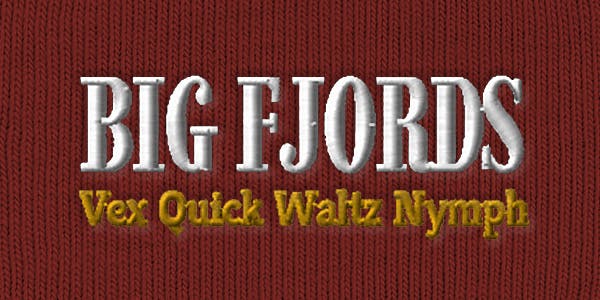
Best Serif style fonts for embroidery
- Imbue Bold
- Kreon
Start with these Serif style fonts
Sans-serif
A sans-serif is a standard font that does not have small lines or flourishes at the ends of the letters. These fonts are considered more modern and minimalist in appearance and are often used for digital displays and web design. Some common examples of sans serif fonts include Arial, Verdana, and Helvetica.
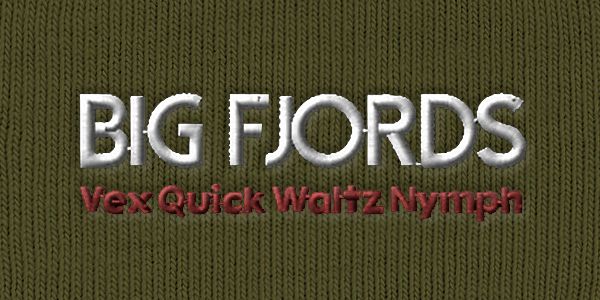
Best San-serif style fonts for embroidery
- Dolce Vita
- Lexend Deca
Start with these Sans Serif style fonts
Block
A block font, also known as a geometric sans serif font, is a standard style based on simple geometric shapes, such as circles and squares. These fonts are known for their clean, modern appearance and are used in headings and other instances where a bold, impactful font is required. Some common examples of block fonts are Futura, Gotham, and Avant Garde.
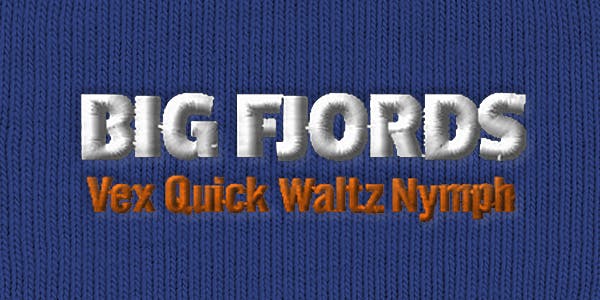
Best Block style fonts for embroidery
- Passion One Bold
- Trade Gothic
Start with these Block style fonts
Cursive
A cursive font, also known as script, is a style that features letters that are connected to each other, creating a handwritten-like appearance. These fonts often add a personal, elegant, or handmade touch to designs. Note that these are not typically well-suited for embroidery, but we highlight two fonts that work.
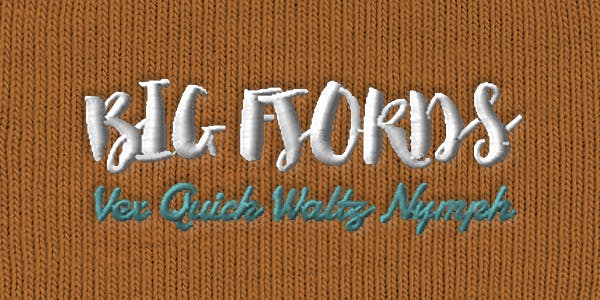
Best Cursive / Script style fonts for embroidery
- Bonjour
- Damion
Start with these Cursive style fonts
Cartoon
A cartoon font style is designed to look like the lettering used in cartoons and comics. These fonts often have a whimsical or playful appearance, and they can be used to add a lighthearted touch to designs. Some common examples of cartoon fonts include Comic Sans (avoid it), Action Jackson, and Kids.
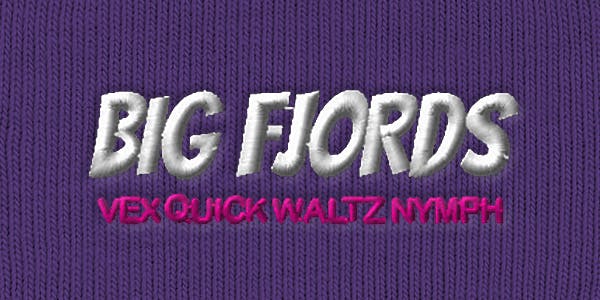
Best Cartoon style fonts for embroidery
- Bangers
- Dongle Bold
Start with these Cartoon style fonts
Novelty
A novelty font is a style designed to be attention-grabbing and distinctive. These fonts often have unusual or unconventional letterforms or refer to pop culture and can be used for parody or to add a distinctive character to a design. Common examples of novelty fonts are Lobster, Chalkduster, and Papyrus.
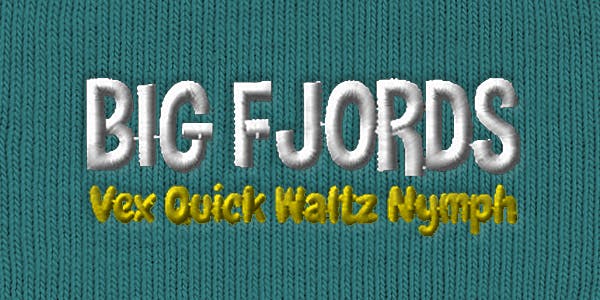
Best Novelty style fonts for embroidery
- Dimbo
- Chewy
Start with these Novelty style fonts
Typewriter
Typewriter font styles are designed to mimic the appearance of text typed on a mechanical typewriter, characterized by its monospaced (evenly spaced) letters and lack of cursive or decorative elements. Typewriter fonts create a vintage or retro aesthetic when you want to evoke a look of the past.
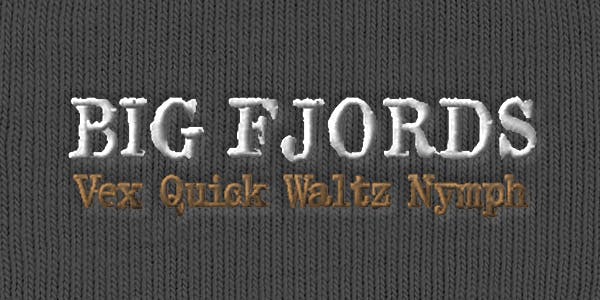
Best Typewriter style fonts for embroidery
- Old Newspaper Types
- Another Typewriter
Start with these Typewriter style fonts
Graffiti
A graffiti font is designed to resemble the style of lettering typically seen in graffiti artwork. Stylized, bold, irregular shapes characterize this type of font, with a marker or spray-painted appearance and distinctive elements such as arrows and stars. When using graffiti fonts for embroidery, the simpler, the better.
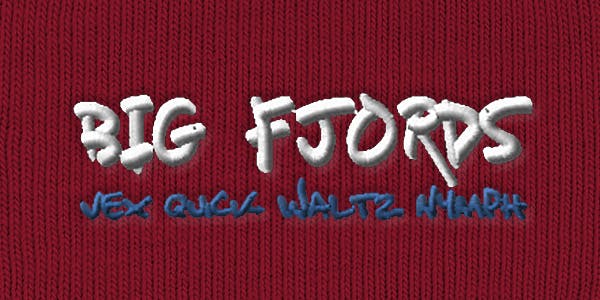
Best Graffiti style fonts for embroidery
- Fresh Marker
- Fatboy Slim
Start with these Graffiti style fonts
Retro
A retro font is a style designed to elicit the classic look of a particular time period from the past. Retro fonts are often used in designs that seek to create a nostalgic or vintage look. They are popular in branding and marketing materials for companies that want to convey a sense of history.
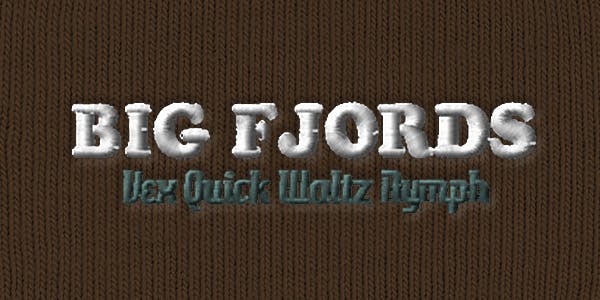
Best Retro style fonts for embroidery
- Cooper Black
- Hamburger Heaven
Start with these Retro style fonts
College
A college font style is one you would see on the back of an athletic jersey. Typically these fonts are all caps, bold like block fonts, and characterized by straight lines and angles. People use these for sports-themed designs and brands, but they are versatile enough for other uses.
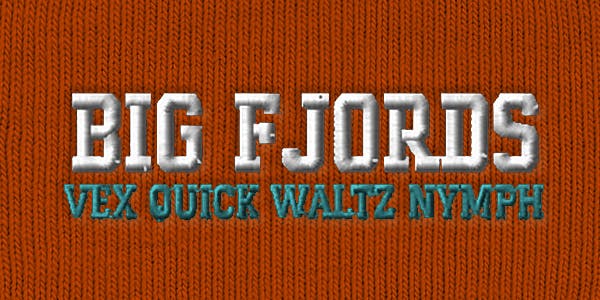
Best College style fonts for embroidery
- Collegiate
- Graduate
Start with these College style fonts
Sci-fi
A sci-fi font is a style designed to evoke the aesthetic of science fiction, characterized by a futuristic or otherworldly appearance, incorporating elements like geometric shapes, symbols, and futuristic flourishes. Sci-fi fonts are often used in designs related to science fiction. Still, they are also prevalent in technology and engineering-related fields, where they can convey a sense of innovation and progress.
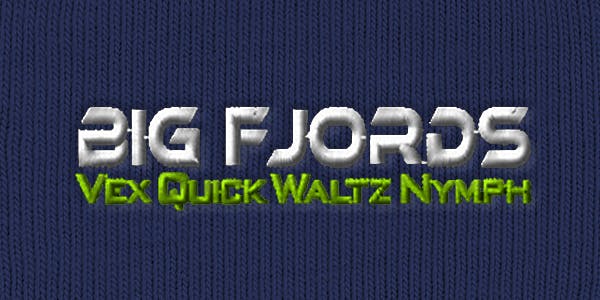
Best Sci-fi style fonts for embroidery
- Ethnocentric
- Banker Square Bold
Start with these Sci-fo style fonts
Groovy
A groovy font is a style designed to evoke the aesthetic of the 1960s and 1970s. This type of font is often characterized by its bold, colorful appearance and may incorporate elements such as curved lines, geometric shapes, and psychedelic flourishes. Groovy fonts are often used in designs that create a retro or nostalgic feel, or are used to convey a fun, laid-back aesthetic.
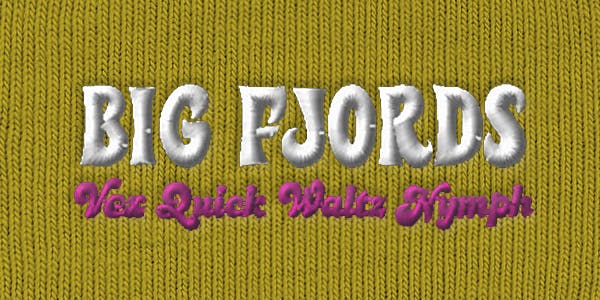
Best Groovy style fonts for embroidery
- Heavy Leap
- PJ Banana Split
Start with these Groovy style fonts
Western
A western font is a style designed to spur the aesthetic of the Wild West. This font type is often characterized by its rough, rugged appearance and may incorporate elements such as serifs, flourishes, and decorative details. They often have the rugged, masculine aesthetic of early American history.
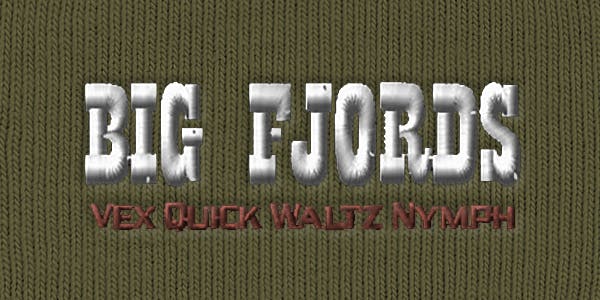
Best Western-style fonts for embroidery
- Playbill
- Bonzer
Start with these Western style fonts
Celtic
A Celtic font is a style based on Celtic cultures and traditions. Intricate, interwoven patterns and decorative elements, such as knots, spirals, and other symbolic designs, often characterize this font type. They can be used to create a historical or mythical aesthetic. Most Celtic fonts are not suited for embroidery, but here are two that can work.

Best Celtic-style fonts for embroidery
- Livingstone
- Dumbledor
Start with these Celtic style fonts
Font styles to avoid for embroidery
Certain font styles are not well suited for embroidery. The factors listed below for each font style can make it challenging to create high-quality embroidery designs using these fonts.
- Handwritten styles can be problematic for custom embroidery because they often have thin, delicate strokes that can be difficult to reproduce accurately with embroidery thread. Additionally, irregular, organic shapes of handwritten-style fonts don't translate well to embroidery.
- Decorative styles can also create issues for embroidery because they often have intricate details and flourishes that are too small to create with embroidery thread. The complex, often overlapping shapes of decorative fonts can end up looking like a mess.
- Digital styles are not ideal because they are designed to be clean and crisp, with thin, delicate strokes and fine details. These characteristics make it difficult to create good-looking embroidery designs, as the stitches are thicker and more coarse than pixels on a screen.
- Distress styles cause problems for custom embroidery because they often have rough, irregular edges and details that can be difficult to reproduce. On top of that, the distressed, worn-out appearance is almost impossible to recreate with embroidery patterns.
- Horror styles are not optimal for custom embroidery because they often have complex, irregular shapes and details that can be difficult to reproduce accurately with embroidery thread, such as dripping blood. If you want to use a horror font, pick one that is simple and bold.
Embroidery font tips
Embroidery adds an elevated, professional touch to any design, making it an excellent choice for staff polos or branded hats. And choosing the right font is essential to ensure your embroidered design stands out.
Here are some helpful tips about fonts we learned from doing hundreds of thousands of custom embroidery jobs.
- Simpler fonts, such as sans serifs, work best for embroidery. Script, handwritten, greek, and decorative fonts can also work well, but it's best to avoid overly complex or thin fonts.
- Use fonts with regular, geometric shapes. Avoid fonts with thin, delicate strokes or complex; irregular shapes can help ensure that your embroidery designs turn out beautifully.
- Size considerations - Embroidered logos and designs are typically small because of smaller print areas, the weight of the embellishment, and the cost of a higher stitch count. Increase the font size, use a simple typeface, or omit small type altogether.
- Thin lines and details - Embroidery has a difficult time with skinny lines and small details, so it's best to omit these from your design when simplifying and avoid using fonts with these characteristics.
- Special characters - Watch out for fonts that use "special characters," which may be hard to reproduce with embroidery thread. Stick with simple, clean typefaces with standard characters.
- Pairing fonts - Pay special attention when using more than one font regarding how they interact and look together. Choose fonts that are complimentary and work well for embroidery.
- Using outlines - Avoid using outlines around your fonts, as they don't translate well to embroidery. Our embroidery machines have a function called "run stitch," which can automatically trace your lettering to provide an outline that works.
Improve your next project with these embroidery fonts
Now that you know the best fonts for embroidery and have a good idea of what works and what doesn't, it's time to create your own custom embroidery design. Jump into our easy-to-use Design Studio and get started today. We're always here if you need any assistance or have additional questions.
Embroidery font FAQs
What is the most common issue regarding embroidery fonts?
Sizing is the most common issue with fonts. If a font is too small, letters tend to bunch and become illegible. On the flip side, bigger is not always better. Fonts look best with satin stitch, and fronts that are too wide or tall can't be done in satin and require a "complex fill," which some people find not to be as clean of a look.
What is the smallest font size for embroidery?
A height of .15" is our minimum. However, that also depends on the chosen font and its particular characteristics. To be safe, we recommend keeping the font height at a .25" minimum whenever possible.
Can I use my own fonts?
Yes. Although we have over 300 fonts to choose from, some customers prefer to upload designs created using their own font choice from elsewhere. Here are the top 10 websites to download free fonts.

Imri Merritt
About the Author
A graduate of the Multimedia program at the University of the Arts in Philadelphia, Imri Merritt is an industry veteran with over 20 years of graphic design and color separations experience in the screen printing industry.

